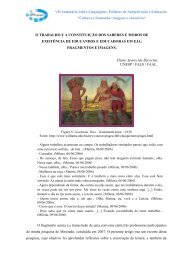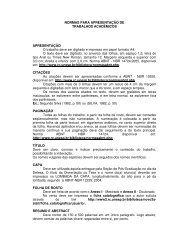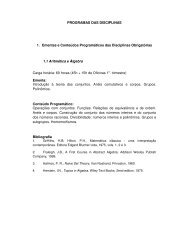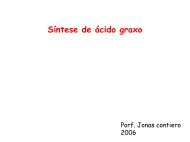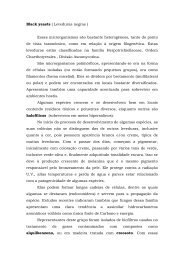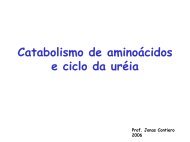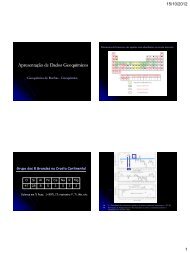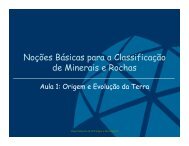Diet and Spatial Pattern of Foraging in Ectatomma opaciventre ...
Diet and Spatial Pattern of Foraging in Ectatomma opaciventre ...
Diet and Spatial Pattern of Foraging in Ectatomma opaciventre ...
You also want an ePaper? Increase the reach of your titles
YUMPU automatically turns print PDFs into web optimized ePapers that Google loves.
607<br />
<strong>Diet</strong> <strong>and</strong> <strong>Spatial</strong> <strong>Pattern</strong> <strong>of</strong> <strong>Forag<strong>in</strong>g</strong> <strong>in</strong> <strong>Ectatomma</strong> <strong>opaciventre</strong><br />
(Hymenoptera: Formicidae) <strong>in</strong> an Anthropic Area<br />
by<br />
Viviane Crist<strong>in</strong>a T<strong>of</strong>olo 1,2 , Edilberto Giannotti 1,3 , Hugo Ribeiro Moleiro 1<br />
& Marcos Rogério Simões 1<br />
ABSTRACT<br />
<strong>Ectatomma</strong> <strong>opaciventre</strong> (Formicidae: Ectatomm<strong>in</strong>ae) presents an <strong>in</strong>dividual<br />
forag<strong>in</strong>g strategy <strong>in</strong> the epigeal stratum. It is a generalist predator, collect<strong>in</strong>g<br />
a wide variety <strong>of</strong> live or recently dead arthropods. The objective <strong>of</strong> this study<br />
was to determ<strong>in</strong>e <strong>in</strong>dividual forag<strong>in</strong>g pathways <strong>and</strong> identify prey types <strong>in</strong><br />
the diet <strong>of</strong> this species. The <strong>in</strong>dividual forag<strong>in</strong>g pathways <strong>of</strong> 3 colonies were<br />
determ<strong>in</strong>ed by follow<strong>in</strong>g foragers <strong>in</strong> the field <strong>and</strong> record<strong>in</strong>g the time <strong>and</strong> maximum<br />
forag<strong>in</strong>g distance from the nest. <strong>Diet</strong> was assessed by the collection <strong>and</strong><br />
identification <strong>of</strong> the prey carried between the m<strong>and</strong>ibles <strong>of</strong> the ants. Foragers<br />
collected ma<strong>in</strong>ly other species <strong>of</strong> ants. The maximum forag<strong>in</strong>g distance was<br />
5.14 m <strong>and</strong> the longest time spent forag<strong>in</strong>g was 66 m<strong>in</strong>utes. The pathways<br />
appeared to be spatially distributed <strong>in</strong> a way that avoids <strong>in</strong>tersection with<br />
pathways from other nests <strong>and</strong> favors search for food <strong>in</strong> areas unexplored by<br />
other <strong>in</strong>dividuals.<br />
INTRODUCTION<br />
The trail system <strong>of</strong> ant colonies <strong>of</strong>fers a mechanism that determ<strong>in</strong>es the<br />
patterns <strong>of</strong> search for food by foragers, direct<strong>in</strong>g them away from neighbor<strong>in</strong>g<br />
colonies (Hölldobler 1976; Harrison & Gentry 1981; Ryti & Case 1986;<br />
Traniello 1988). It also reduces search time, lead<strong>in</strong>g foragers to a persistent<br />
resource (Hölldobler 1976; Shepherd 1982, 1985). The food search pattern<br />
may consist <strong>of</strong> the use <strong>of</strong> a forag<strong>in</strong>g area by populations, so that <strong>in</strong>tra- <strong>and</strong><br />
<strong>in</strong>terspecific territorial <strong>in</strong>teractions contribute to the partition<strong>in</strong>g <strong>of</strong> the environment<br />
between colonies. Furthermore, each search started by a forager<br />
may have a particular spatial <strong>and</strong> temporal organization, which is ecologically<br />
1 Universidade Estadual Paulista [São Paulo State University] Júlio de Mesquita Filho, Zoology<br />
Department - Av. 24-A, 1515 - Bela Vista - CEP: 13506-900 - Rio Claro, SP, Brazil.<br />
2 E-mail: vivit<strong>of</strong>olo@yahoo.com.br<br />
3 E-mail: edilgian@rc.unesp.br
608 Sociobiology Vol. 58, No. 3, 2011<br />
<strong>in</strong>fluenced. There is also a relation between <strong>in</strong>dividual <strong>and</strong> collective search<br />
patterns, s<strong>in</strong>ce the forager may <strong>in</strong>fluence the search patterns <strong>of</strong> a nestmate<br />
through communication. Therefore, the distribution <strong>of</strong> resources <strong>in</strong> space<br />
<strong>and</strong> time should be the ma<strong>in</strong> <strong>in</strong>fluences upon the organization <strong>of</strong> search<br />
(Traniello 1989).<br />
There is a tendency for ant species with small colonies to forage <strong>in</strong>dividually<br />
<strong>and</strong> not to present complex recruitment systems, because <strong>in</strong>dividuals <strong>in</strong>teract<br />
directly with few foragers. On the other h<strong>and</strong>, colonies with a lot <strong>of</strong> <strong>in</strong>dividuals<br />
rely on long-term chemical communication between the <strong>in</strong>dividuals, allow<strong>in</strong>g<br />
for rapid recruitment <strong>of</strong> numerous foragers. Between these extremes, there<br />
are <strong>in</strong>termediate behaviors such as t<strong>and</strong>em runn<strong>in</strong>g, group recruitment, <strong>and</strong><br />
mass recruitment (Beckers et al. 1989). In Ectatomm<strong>in</strong>ae, foragers may use<br />
a wide variety <strong>of</strong> strategies to obta<strong>in</strong> food. The forag<strong>in</strong>g methods may vary<br />
from hunt<strong>in</strong>g <strong>in</strong>dependently, with no cooperation dur<strong>in</strong>g food search <strong>and</strong><br />
collection, to various degrees <strong>of</strong> cooperation, with different levels <strong>of</strong> communication<br />
<strong>and</strong> recruitment between nestmates. However, a wide range <strong>of</strong><br />
feed<strong>in</strong>g habits can be observed from species to species, <strong>in</strong>clud<strong>in</strong>g the collection<br />
<strong>of</strong> seeds, fruits, liv<strong>in</strong>g prey, <strong>and</strong> <strong>in</strong>sect secretions (Hölldobler & Wilson<br />
1990; Medeiros & Oliveira 2009).<br />
Among the ants <strong>of</strong> the genus <strong>Ectatomma</strong>, endemic to South <strong>and</strong> Central<br />
America (Brown-Jr 1958; Bolton 1995), several forag<strong>in</strong>g strategies may occur,<br />
such as ambush predation, solitary hunt<strong>in</strong>g, cooperative <strong>and</strong> group hunt<strong>in</strong>g,<br />
<strong>and</strong> even cleptobiosis (Perfecto & V<strong>and</strong>er Meer 1993; Schatz & Wcislo 1999).<br />
As their colonies are small, forag<strong>in</strong>g is more <strong>of</strong>ten solitary (Hölldobler &<br />
Wilson 1990). With a large, functional st<strong>in</strong>g <strong>and</strong> well-developed m<strong>and</strong>ibles,<br />
they are capable <strong>of</strong> subjugat<strong>in</strong>g large, aggressive prey, a characteristic typical<br />
<strong>of</strong> essentially predator species (Hölldobler & Wilson 1990; Wheeler 1986;<br />
Giannotti & Machado 1992; Fernández 1991; Oliveira & Br<strong>and</strong>ão 1991;<br />
Del-Claro & Oliveira 1999; Pie 2004). Regarded as a generalist predator,<br />
<strong>Ectatomma</strong> <strong>opaciventre</strong> uses the hypogeal stratum for nest<strong>in</strong>g <strong>and</strong> the epigeal<br />
for forag<strong>in</strong>g a wide variety <strong>of</strong> arthropods <strong>and</strong> annelids, liv<strong>in</strong>g or recently dead<br />
(Fernández 1991; Pie 2004).<br />
The objective <strong>of</strong> this research was to determ<strong>in</strong>e <strong>in</strong>dividual forag<strong>in</strong>g pathways<br />
<strong>of</strong> workers <strong>of</strong> E. <strong>opaciventre</strong> <strong>and</strong> identify prey types <strong>in</strong> the diet <strong>of</strong> this<br />
species <strong>in</strong> an anthropic area.
T<strong>of</strong>olo, V.C. et al. — <strong>Spatial</strong> <strong>Pattern</strong> <strong>of</strong> <strong>Forag<strong>in</strong>g</strong> <strong>in</strong> E. <strong>opaciventre</strong><br />
MATERIAL AND METHODS<br />
Three nests <strong>of</strong> E. <strong>opaciventre</strong> were found <strong>in</strong> an urban area <strong>of</strong> 4,800 m 2 <strong>in</strong><br />
the city <strong>of</strong> Rio Claro, SP, Brazil (22º 22'42.31"S <strong>and</strong> 47º 33'38.67"W). This<br />
grass-covered area was frequently used for garbage disposal <strong>and</strong> <strong>of</strong>ten set on<br />
fire. The forag<strong>in</strong>g pathways were determ<strong>in</strong>ed based on the focal-animal sampl<strong>in</strong>g<br />
method. Foragers were <strong>in</strong>dividually observed from the moment they left<br />
the nest until they returned. As the ant moved, a numbered tag was placed<br />
on the ground every 20 cm (Fig. 1). In cases where ants appeared disturbed<br />
by the observer, the data were discarded. The duration <strong>of</strong> the forag<strong>in</strong>g trip<br />
<strong>and</strong> maximum forag<strong>in</strong>g distance was recorded for 10 <strong>in</strong>dividuals per nest,<br />
for a total <strong>of</strong> 30 observations. An analysis <strong>of</strong> variance with a 95%-confidence<br />
<strong>in</strong>terval was carried out <strong>in</strong> order to verify whether there were differences <strong>in</strong><br />
the forag<strong>in</strong>g distance <strong>and</strong> time between the 3 nests studied. Then, BioEstat<br />
s<strong>of</strong>tware, version 3.0, was used to calculate the Spearman’s correlation coefficient<br />
between the time <strong>and</strong> distance <strong>of</strong> forag<strong>in</strong>g.<br />
To evaluate the diet <strong>of</strong> the ants, we recorded the number <strong>of</strong> workers leav<strong>in</strong>g<br />
<strong>and</strong> enter<strong>in</strong>g the nest <strong>and</strong> we collected, with tweezers, the items that they<br />
Fig. 1. Representation <strong>of</strong> the numbered tags placed every 20 cm to follow movement by the foragers<br />
<strong>of</strong> <strong>Ectatomma</strong> <strong>opaciventre</strong>.<br />
609
610 Sociobiology Vol. 58, No. 3, 2011<br />
carried to the nest <strong>in</strong> their m<strong>and</strong>ibles. The observations were made <strong>in</strong> the dry<br />
season from 14:00 to 18:00, which corresponds to the period <strong>of</strong> the highest<br />
forag<strong>in</strong>g activity for this species <strong>in</strong> the afternoon (Pie 2004). The total time<br />
<strong>of</strong> observation was 72 hours. The food collected was stored <strong>in</strong> 70% alcohol<br />
for further identification.<br />
RESULTS<br />
<strong>Forag<strong>in</strong>g</strong> pathways<br />
The workers <strong>of</strong> E. <strong>opaciventre</strong> foraged on average at a maximum distance <strong>of</strong><br />
2.18m ± 1.6m (SD) (range: 0.40-5.14 m), spend<strong>in</strong>g on average 28.1 ± 15.6<br />
m<strong>in</strong> (SD) (range: 8- 66) outside their nest. The maximum forag<strong>in</strong>g distance<br />
from the nest <strong>and</strong> the trip duration are presented <strong>in</strong> Table 1. Workers <strong>of</strong> nests<br />
1, 2, <strong>and</strong> 3 showed no significant difference <strong>in</strong> the distance or time <strong>of</strong> forag<strong>in</strong>g<br />
(p> 0.05). The Spearman’s rank correlation coefficient for the variables<br />
time <strong>and</strong> distance was r = 0.848 (p
T<strong>of</strong>olo, V.C. et al. — <strong>Spatial</strong> <strong>Pattern</strong> <strong>of</strong> <strong>Forag<strong>in</strong>g</strong> <strong>in</strong> E. <strong>opaciventre</strong><br />
The forag<strong>in</strong>g trails presented a s<strong>in</strong>uous pattern from the beg<strong>in</strong>n<strong>in</strong>g to the end,<br />
with directional fidelity (Fig. 2). The pathways from nest 1 were concentrated<br />
around the nest along the north-south axis; <strong>in</strong> nest 2, they were distributed<br />
southeast <strong>and</strong> northwest to the nest; <strong>and</strong> <strong>in</strong> nest 3, they were west-oriented.<br />
Thus, the foragers were spatially distributed <strong>in</strong> the forag<strong>in</strong>g area so as to avoid<br />
overlap with the trails from neighbor<strong>in</strong>g colonies. These areas were explored<br />
repeatedly, demonstrat<strong>in</strong>g the preference <strong>of</strong> colonies for specific regions <strong>in</strong><br />
the forag<strong>in</strong>g arena. In the 3 colonies, most trajectories were close to the nest,<br />
with few pathways more than two meters away from it.<br />
<strong>Diet</strong> <strong>and</strong> forag<strong>in</strong>g effort<br />
Dur<strong>in</strong>g the observation period, few foragers left the nest <strong>in</strong> search <strong>of</strong> food<br />
resources. The workers <strong>of</strong> E. <strong>opaciventre</strong> left the nest on average 5.4 ± 2.7 (SD)<br />
times per forag<strong>in</strong>g hour, return<strong>in</strong>g almost at the same rate, 4.9 ± 2.5 (SD)<br />
times. Of the 371 forag<strong>in</strong>g trips recorded, only 9.16% ended with the workers<br />
return<strong>in</strong>g with prey. Liquid food was not observed <strong>in</strong> the m<strong>and</strong>ibles <strong>of</strong> the<br />
foragers, only solids. The description <strong>of</strong> the prey captured is shown <strong>in</strong> Table<br />
2. Over half <strong>of</strong> the prey items collected (52.78%) belonged to Formicidae,<br />
<strong>in</strong>clud<strong>in</strong>g an <strong>in</strong>dividual <strong>of</strong> the same genus, E. brunneum. All the prey were<br />
collected <strong>in</strong>dividually except a chrysalis <strong>of</strong> Lepidoptera for which there was a<br />
recruitment strategy known as social facilitation. In this event, an <strong>in</strong>dividual<br />
recruited a nestmate to collect the prey item without us<strong>in</strong>g a scent trail. As<br />
the prey was too large <strong>and</strong> fixed to the substrate by silk threads, the forager<br />
quickly returned to the nest <strong>and</strong> then left, followed by another ant. The<br />
recruited ant followed the recruiter to the food source <strong>and</strong> both cut the silk<br />
threads to collect <strong>and</strong> transport the food item to the nest.<br />
DISCUSSION<br />
The diet <strong>of</strong> E. <strong>opaciventre</strong> was narrow, probably because the nests were<br />
located <strong>in</strong> a degraded area <strong>and</strong> the research was carried out <strong>in</strong> the dry season.<br />
In the Brazilian savannah (Cerrado), Pie (2004) observed that, <strong>in</strong> 50% <strong>of</strong> the<br />
cases, the diet <strong>of</strong> E. <strong>opaciventre</strong> is composed <strong>of</strong> termites, <strong>and</strong> over 20% <strong>of</strong> the<br />
other prey consists <strong>of</strong> other ants, ma<strong>in</strong>ly those <strong>of</strong> the genus Atta.<br />
Wheeler (1986) analyzed the diet <strong>of</strong> E. tuberculatum <strong>in</strong> Panama, also us<strong>in</strong>g<br />
the method <strong>of</strong> collect<strong>in</strong>g prey items that workers carried to the nest. Insects<br />
611
612 Sociobiology Vol. 58, No. 3, 2011<br />
Fig. 2. <strong>Spatial</strong> pattern <strong>of</strong> forag<strong>in</strong>g <strong>in</strong> three colonies <strong>of</strong> <strong>Ectatomma</strong> <strong>opaciventre</strong><br />
<strong>in</strong> a degraded area <strong>in</strong> Rio Claro, SP, Brazil
T<strong>of</strong>olo, V.C. et al. — <strong>Spatial</strong> <strong>Pattern</strong> <strong>of</strong> <strong>Forag<strong>in</strong>g</strong> <strong>in</strong> E. <strong>opaciventre</strong><br />
Table 2 . Items collected by foragers <strong>of</strong> <strong>Ectatomma</strong> <strong>opaciventre</strong> <strong>in</strong> the<br />
field. The numbers <strong>in</strong> parentheses represent the relative abundance (%)<br />
<strong>of</strong> the items <strong>in</strong> each group.<br />
Prey Amount (%)<br />
Hymenoptera (55.56%)<br />
Ichneumonidae 1 (2.78)<br />
Formicidae (52.78%)<br />
(Ectatomm<strong>in</strong>ae) <strong>Ectatomma</strong> brunneum 1 (2.78)<br />
(Formic<strong>in</strong>ae) Camponotus rufipes 3 (8.33)<br />
(Dolichoder<strong>in</strong>ae) Conomyrma 5 (13.89)<br />
(Myrmic<strong>in</strong>ae) Pseudomyrmex 5 (13.89)<br />
(Myrmic<strong>in</strong>ae) Pheidole 5 (13.89)<br />
Lepidoptera (5.56%)<br />
Pyralidae 1 (2.78)<br />
Unidentified chrysalis 1 (2.78)<br />
Coleoptera (13.89%)<br />
Mycetophagidae 2 (5.56)<br />
Curculionidae 2 (5.56)<br />
Unidentified 1 (2.78)<br />
Araneae (2.78%)<br />
Salticidae 1 (2.78)<br />
Fragments (13.89%)<br />
Orthoptera 1 (2.78)<br />
Coleoptera 2 (5.56)<br />
Formicidae 2 (5.56)<br />
Grass seeds (8.33%) 3 (8.33)<br />
<strong>and</strong> other <strong>in</strong>vertebrates, liv<strong>in</strong>g or dead, were collected. Some <strong>of</strong> them were<br />
large <strong>and</strong> highly aggressive. Ants, especially Gnamptogenys, Odontomachus,<br />
Pheidole, Azteca, <strong>and</strong> Camponotus, were an important part <strong>of</strong> this diet (Pie<br />
2004; Pratt 1989). The same pattern was reported <strong>in</strong> a study by Giannotti <strong>and</strong><br />
Machado (1992). They recorded 20 types <strong>of</strong> food <strong>of</strong> animal orig<strong>in</strong> (<strong>in</strong>sects<br />
<strong>and</strong> <strong>in</strong>vertebrates) <strong>and</strong> several others <strong>of</strong> vegetal orig<strong>in</strong> (like seeds, pulp, leaves,<br />
613
614 Sociobiology Vol. 58, No. 3, 2011<br />
<strong>and</strong> roots) <strong>in</strong> the diet <strong>of</strong> E. brunneum (=quadridens). A preference for ants<br />
was also observed <strong>in</strong> E. permagnum, which showed a diet consist<strong>in</strong>g almost<br />
exclusively <strong>of</strong> workers <strong>and</strong> w<strong>in</strong>ged <strong>in</strong>dividuals <strong>of</strong> Pheidole <strong>and</strong> Camponotus<br />
(Paiva & Br<strong>and</strong>ão 1989), <strong>and</strong> <strong>in</strong> Pachycondyla striata, which <strong>in</strong>cludes <strong>in</strong> its<br />
diet foragers <strong>of</strong> Odontomachus, Camponotus, Pheidole, Solenopsis, Atta, <strong>and</strong><br />
even other Pachycondyla (Medeiros & Oliveira 2009).<br />
The proportion <strong>of</strong> ants preyed on by E. ruidum was observed to be similar<br />
both <strong>in</strong> the dry (18.8%) <strong>and</strong> <strong>in</strong> the ra<strong>in</strong>y (17.2%) season. Although its diet<br />
consisted <strong>of</strong> 19 items, almost 30% <strong>of</strong> them corresponded to liquids rich <strong>in</strong><br />
carbohydrates, such as extrafloral nectar, honeydew, <strong>and</strong> fruit pulp (Lachaud<br />
1990). Similarly, <strong>in</strong> E. tuberculatum, liquid foods represented more than 35%<br />
<strong>of</strong> its diet (Valenzuela-González et al. 1995). Collect<strong>in</strong>g resources <strong>of</strong> animal<br />
orig<strong>in</strong> requires longer forag<strong>in</strong>g distances; captur<strong>in</strong>g <strong>and</strong> transport<strong>in</strong>g them<br />
is more time consum<strong>in</strong>g compared with liquid foods (Harkness & Harkness<br />
1976; Fourcassié & Oliveira 2002). This “preference” for other ants is not<br />
likely to be due to selectivity by the foragers, but to the low diversity <strong>of</strong> food<br />
items available <strong>in</strong> the environment. This can be proved <strong>in</strong> the laboratory, s<strong>in</strong>ce<br />
workers <strong>of</strong> E. <strong>opaciventre</strong> easily accept other food items, such as mealworms,<br />
which are not found <strong>in</strong> their natural environment.<br />
The predatory behavior observed <strong>in</strong> E. <strong>opaciventre</strong> was very similar to that<br />
found by Pie (2004) <strong>in</strong> the Brazilian savanna <strong>and</strong> by T<strong>of</strong>olo <strong>and</strong> Giannotti<br />
(2009) <strong>in</strong> the laboratory: prey aggressiveness determ<strong>in</strong>ed the type <strong>of</strong> approach<br />
used by the workers. As a consequence <strong>of</strong> the absence <strong>of</strong> recruitment previously<br />
described for this species, the size <strong>of</strong> the food item collected was dependent<br />
on the capacity <strong>of</strong> the worker to carry it without help, one at a time. This<br />
behavior is characterized as social facilitation, that is, the return <strong>of</strong> a forager<br />
to the nest that may <strong>in</strong>crease activity <strong>in</strong>side the nest, lead<strong>in</strong>g other collectors<br />
to leave <strong>and</strong> search for food sources even <strong>in</strong> the absence <strong>of</strong> a chemical trail or<br />
any other directional <strong>in</strong>formation, as observed <strong>in</strong> Pachycondyla goeldii (Orivel<br />
2000) <strong>and</strong> E. ruidum (Lachaud 1985).<br />
In the degraded area studied, the foragers <strong>of</strong> E. <strong>opaciventre</strong> did not stay<br />
more than 5.14 m away from the nest. A similar behavior was observed by<br />
Medeiros <strong>and</strong> Oliveira (2009) <strong>in</strong> numerous colonies <strong>of</strong> Pachycondyla striata.<br />
Fourcassié <strong>and</strong> Oliveira (2002) reported that, <strong>in</strong> D<strong>in</strong>oponera quadriceps,<br />
this distance was more than twice as long, reach<strong>in</strong>g 13 m. Pie (2004) also
T<strong>of</strong>olo, V.C. et al. — <strong>Spatial</strong> <strong>Pattern</strong> <strong>of</strong> <strong>Forag<strong>in</strong>g</strong> <strong>in</strong> E. <strong>opaciventre</strong><br />
recorded site fidelity <strong>in</strong> the area explored by workers <strong>of</strong> E. <strong>opaciventre</strong>, that is,<br />
the forager tended to have a preference for a specific forag<strong>in</strong>g pathway, which<br />
made it a specialist <strong>in</strong> the <strong>in</strong>dividual exploration <strong>of</strong> sub-areas, becom<strong>in</strong>g able<br />
to return to the nest quickly. The same pattern was observed <strong>in</strong> Pachycondyla<br />
apicalis (Fresneau 1985; Deneubourg et al. 1987), D. quadriceps (Azevedo<br />
2009), D. gigantea (Fourcassié & Oliveira 2002), Cataglyphis exhibits, <strong>and</strong><br />
C. bicolor (Buchkremer & Re<strong>in</strong>old 2008).<br />
Fresneau (1985) proposed a simple mechanism to expla<strong>in</strong> such fidelity:<br />
dur<strong>in</strong>g the first trip, new foragers select a portion <strong>of</strong> the forag<strong>in</strong>g area, which is<br />
confirmed by the capture <strong>of</strong> the first prey. Through a simple learn<strong>in</strong>g process,<br />
the ants keep search<strong>in</strong>g <strong>in</strong> the same area dur<strong>in</strong>g the follow<strong>in</strong>g trips. If foragers<br />
from the same colony meet <strong>in</strong> an overlapp<strong>in</strong>g area, both make <strong>in</strong>tense antennal<br />
contact before leav<strong>in</strong>g for different pathways. This mechanism <strong>in</strong>duces the<br />
forager to decrease search for food <strong>in</strong> areas used by other foragers, <strong>in</strong>creas<strong>in</strong>g<br />
the effectiveness <strong>of</strong> forag<strong>in</strong>g on a colony-basis. Gordon (1995) believes that<br />
follow<strong>in</strong>g the same direction enables foragers to explore a specific fan-shaped<br />
area, so as to deplete the resources <strong>in</strong> one direction before mov<strong>in</strong>g to the adjacent<br />
area. This way, when they return to the <strong>in</strong>itial position, the resources<br />
are available aga<strong>in</strong>. This was also observed <strong>in</strong> P. striata (Medeiros & Oliveira<br />
2009), <strong>in</strong> the desert ant Veromessor perg<strong>and</strong>ei (Riss<strong>in</strong>g & Wheeler 1976), <strong>and</strong><br />
<strong>in</strong> the army ant Eciton burchelii (Franks & Fletcher 1983).<br />
Seem<strong>in</strong>gly, the <strong>in</strong>dividual forag<strong>in</strong>g pathways <strong>of</strong> E. <strong>opaciventre</strong> are spatially<br />
oriented so as to avoid overlap with those from other nests, thus m<strong>in</strong>imiz<strong>in</strong>g<br />
competition with <strong>in</strong>dividuals <strong>of</strong> other species. Consider<strong>in</strong>g that collectors<br />
do not use chemical markers on their forag<strong>in</strong>g trails, researchers believe that<br />
l<strong>and</strong>mark cues contributed primarily to the orientation <strong>of</strong> these ants <strong>in</strong> the<br />
field, as observed <strong>in</strong> D. quadriceps (Azevedo 2009), D. gigantea (Fourcassié<br />
et al. 1999), <strong>and</strong> Paraponera clavata (Deneubourg et al. 1987, Baader 1996).<br />
There are no studies prov<strong>in</strong>g magnetic orientation <strong>in</strong> E. <strong>opaciventre</strong>.<br />
D<strong>in</strong>oponera quadriceps also presented a positive correlation between<br />
maximum distance to the nest <strong>and</strong> duration <strong>of</strong> forag<strong>in</strong>g trip, with a s<strong>in</strong>uous<br />
movement pattern <strong>and</strong> directional preference (Azevedo 2009). Accord<strong>in</strong>g to<br />
Bonser et al. (1998), the time spent <strong>in</strong> the forag<strong>in</strong>g area depends on the nest<br />
distance, <strong>and</strong> further areas must be explored less frequently <strong>and</strong> for longer<br />
615
616 Sociobiology Vol. 58, No. 3, 2011<br />
periods than closer areas. This would expla<strong>in</strong> the higher number <strong>of</strong> <strong>in</strong>dividual<br />
forag<strong>in</strong>g pathways <strong>of</strong> E. <strong>opaciventre</strong> closer to the nest.<br />
Therefore, forag<strong>in</strong>g strategies seem to depend upon several ecological<br />
variables, such as the distribution <strong>of</strong> food resources <strong>in</strong> time <strong>and</strong> space, food<br />
size <strong>and</strong> quality, competition, <strong>and</strong> predation. A colony must then have a spatial<br />
pattern <strong>of</strong> forag<strong>in</strong>g to collect food effectively <strong>and</strong> m<strong>in</strong>imize the chance<br />
<strong>of</strong> competition, <strong>in</strong> order to assure less energy waste <strong>and</strong> a greater <strong>in</strong>put <strong>of</strong><br />
resources <strong>in</strong> the shortest time.<br />
CONCLUSION<br />
The diversity <strong>of</strong> prey collected by E. <strong>opaciventre</strong> <strong>in</strong> the area studied was<br />
low, most probably because <strong>of</strong> the poor variety <strong>of</strong> species <strong>in</strong> the degraded<br />
environment <strong>and</strong> because the observations were carried out <strong>in</strong> the dry season.<br />
Collect<strong>in</strong>g other ant species as the major part <strong>of</strong> its diet was likely due to the<br />
abundance <strong>and</strong> high richness <strong>of</strong> <strong>in</strong>dividuals belong<strong>in</strong>g to several subfamilies <strong>of</strong><br />
Formicidae <strong>in</strong> the area studied. The forag<strong>in</strong>g trails <strong>of</strong> E. <strong>opaciventre</strong> presented<br />
a pattern similar to those observed <strong>in</strong> other Ectatomm<strong>in</strong>ae studied. With a<br />
s<strong>in</strong>uous pr<strong>of</strong>ile <strong>and</strong> directional fidelity, these trails avoid competition with<br />
other nests <strong>and</strong> lead to a better division <strong>of</strong> the resources explored. Although<br />
most trips were unsuccessful, the foragers did not stray too far from the nest,<br />
nor did they spend too much time forag<strong>in</strong>g. S<strong>in</strong>ce the area was dom<strong>in</strong>ated by<br />
grass, <strong>in</strong>tense sunlight <strong>and</strong> heat was present, which could have caused the ants<br />
physical exhaustion if they had extended the time spent outside the nest.<br />
ACKNOWLEDGMENTS<br />
We thank the National Council for Scientific <strong>and</strong> Technological Development<br />
(CNPq) for the f<strong>in</strong>ancial support.<br />
REFERENCES<br />
Azevedo, D.L.O. 2009. O papel das rotas e da obtenção de <strong>in</strong>formações sobre a eficiência<br />
no forrageio de D<strong>in</strong>oponera quadriceps em ambiente natural. Tese de mestrado em<br />
Psicobiologia pela Universidade Federal do Rio Gr<strong>and</strong>e do Norte, Natal/RN, 83p.<br />
Baader, A. P. 1996. The significance <strong>of</strong> visual l<strong>and</strong>marks for navigation <strong>of</strong> the giant tropical<br />
ant, Paraponera clavata (Formicidae, Poner<strong>in</strong>ae). Insectes Sociaux, 43: 435-450.<br />
Beckers, R., S. Goss, J.L. Deneubourg, & J.M. Pasteels 1989. Colony size, communication<br />
<strong>and</strong> ant forag<strong>in</strong>g strategy. Psyche, 96: 239-256.
T<strong>of</strong>olo, V.C. et al. — <strong>Spatial</strong> <strong>Pattern</strong> <strong>of</strong> <strong>Forag<strong>in</strong>g</strong> <strong>in</strong> E. <strong>opaciventre</strong><br />
Bolton, B. 1995. A new general catalogue <strong>of</strong> the ants <strong>of</strong> the world. Cambridge, MA: Harvard<br />
University Press, 504 p.<br />
Bonser, R., P.J. Wright, S. Bament & U.O. Chukwu 1998. Optimal patch use by forag<strong>in</strong>g<br />
workers <strong>of</strong> Lasius fulig<strong>in</strong>osus, L. niger <strong>and</strong> Myrmica rug<strong>in</strong>odis. Ecological Entomology<br />
23: 15-21.<br />
Brown-Jr, W.L. 1958. Contributions toward a reclassification <strong>of</strong> the Formicidae. II Tribe<br />
Ectatomm<strong>in</strong>ae (Hymenoptera). Bullet<strong>in</strong> <strong>of</strong> the Museum <strong>of</strong> Comparative Zoology at<br />
Harvard 118: 175-362.<br />
Buchkreimer, E.M. & K. Re<strong>in</strong>hold 2008. Sector fidelity – an advantageous forag<strong>in</strong>g behavior<br />
result<strong>in</strong>g from a heuristic strategy. Behavioral Ecology 19: 984-989.<br />
Del-Claro, K. & P.S. Oliveira 1999. Ant-homoptera <strong>in</strong>teractions <strong>in</strong> a neotropical savanna: the<br />
honeydew-produc<strong>in</strong>g treehopper Guayaquila xiphias (Membracidae) <strong>and</strong> its associated<br />
ant fauna on Didymopanax v<strong>in</strong>osum (Araliaceae). Biotropica 31: 135-144.<br />
Deneubourg, J.L., S. Goss, J.M. Pasteels, D. Fresneau & J.-P. Lachaud 1987. Self-organization<br />
mechanisms <strong>in</strong> ant societies (II): learn<strong>in</strong>g <strong>in</strong> forag<strong>in</strong>g <strong>and</strong> division <strong>of</strong> labor. Experimentia<br />
Supplementum 54: 177-196.<br />
Fernández, F. 1991. Las hormigas cazadoras del genero <strong>Ectatomma</strong> (Hymenoptera:<br />
Formicidae) en Colombia. Caldasia 16:551-564.<br />
Fourcassié, V. & P.S. Oliveira 2002. <strong>Forag<strong>in</strong>g</strong> ecology <strong>of</strong> the giant Amazonian ant D<strong>in</strong>oponera<br />
gigantea (Hymenoptera: Formicidae: Poner<strong>in</strong>ae): activity schedule, diet <strong>and</strong> spatial<br />
forag<strong>in</strong>g patterns. Journal <strong>of</strong> Natural History 36: 2211-2227.<br />
Fourcassié, V., A. Henriques & C. Fontella 1999. Route fidelity <strong>and</strong> spatial orientation <strong>in</strong> the<br />
ant D<strong>in</strong>oponera gigantea (Hymenoptera: Formicidae) <strong>in</strong> a primary forest: a prelim<strong>in</strong>ary<br />
study. Sociobiology 34: 505-524.<br />
Franks, N.R. & C.A. Fletcher 1983. <strong>Spatial</strong> patterns <strong>in</strong> army ants forag<strong>in</strong>g <strong>and</strong> migration:<br />
Eciton burchelii on Barro Colorado Isl<strong>and</strong>, Panama. Behavioral Ecology <strong>and</strong> Sociobiology<br />
12: 261-270.<br />
Fresneau, D. 1985. Individual forag<strong>in</strong>g <strong>and</strong> path fidelity <strong>in</strong> a poner<strong>in</strong>e ant. Insectes Sociaux,<br />
32: 109-116.<br />
Giannotti, E. & V.L.L. Machado 1992. Notes on the forag<strong>in</strong>g <strong>of</strong> two species <strong>of</strong> poner<strong>in</strong>e<br />
ants: food resources <strong>and</strong> daily hunt<strong>in</strong>g activities (Hymenoptera: Formicidae). Bioikos<br />
6(1,2): 7-17.<br />
Gordon, D.M. 1995. The development <strong>of</strong> an ant colony’s forag<strong>in</strong>g range. Animal Behavior<br />
49: 649-659.<br />
Harkness, M.L.R. & R.D. Harkness 1976. Functional differences between <strong>in</strong>dividual ants<br />
Cataglyphis bicolor. The Journal <strong>of</strong> Physiology 25: 124-125.<br />
Harrison, J.S. & J.B. Gentry 1981. <strong>Forag<strong>in</strong>g</strong> pattern, colony distribution, <strong>and</strong> forag<strong>in</strong>g range<br />
<strong>of</strong> the Florida harvester ant, Pogonomyrmex badius. Ecology 62: 1467-1473.<br />
Hölldobler, B. 1976. Recruitment behavior, home range orientation <strong>and</strong> territoriality <strong>in</strong><br />
harvester ants, Pogonomyrmex. Behavioral Ecology <strong>and</strong> Sociobiology, 1: 3-44.<br />
Hölldobler, B. & E.O. Wilson 1990. The ants. Cambridge, MA: Belknap Press <strong>of</strong> Harvard<br />
University Press, 732p.<br />
617
618 Sociobiology Vol. 58, No. 3, 2011<br />
Lachaud, J.P. 1985. Recruitment by selective activation, an archaic type <strong>of</strong> mass recruitment<br />
<strong>in</strong> a poner<strong>in</strong>e ant (<strong>Ectatomma</strong> ruidum). Sociobiology 11: 133-142.<br />
Lachaud, J.P. 1990. <strong>Forag<strong>in</strong>g</strong> activity <strong>and</strong> diet <strong>in</strong> some Neotropical poner<strong>in</strong>e ants. I.<br />
<strong>Ectatomma</strong> ruidum Roger (Hymenoptera, Formicidae). Folia Entomológica Mexicana<br />
78: 241–256.<br />
Medeiros, F.N.S. & P.S Oliveira 2009. Season-dependent forag<strong>in</strong>g patterns. Case study <strong>of</strong><br />
a Neotropical forest-dwell<strong>in</strong>g ant (Pachycondyla striata, Poner<strong>in</strong>ae). In: Stefan Jarau &<br />
Michael Hrncir (eds.). Food exploitation by social <strong>in</strong>sects: ecological, behavioral, <strong>and</strong><br />
theoretical approaches. Boca Raton: Taylor & Francis Group, p. 81-95.<br />
Oliveira, P.S. & C.R.F. Br<strong>and</strong>ão 1991. The ant community associated with extrafloral nectaries<br />
<strong>in</strong> Brazilian Cerrados. In: D.F. Cutler & C.R. Huxley (eds.). Ant-plant <strong>in</strong>teractions.<br />
Oxford: Oxford University Press, p.198-212.<br />
Orivel, J., A. Souchal, P. Cerdan & A. Dejean 2000. Prey capture behavior <strong>of</strong> the arboreal<br />
poner<strong>in</strong>e ant Pachycondyla goeldii (Hymenoptera: Formicidae). Sociobiology 35: 131-<br />
140.<br />
Paiva, R.V.S. & C.R.F. Br<strong>and</strong>ão 1989. Estudos sobre a organização social de <strong>Ectatomma</strong><br />
permagnum Forel, 1908 (Hymenoptera: Formicidae). Revista Brasileira de Biologia<br />
49: 783-792.<br />
Perfecto, I. & J.H. V<strong>and</strong>er Meer 1993. Cleptobiosis <strong>in</strong> the ant <strong>Ectatomma</strong> ruidum <strong>in</strong> Nicaragua.<br />
Insectes Sociaux 40: 295-299.<br />
Pie, M.R. 2004. <strong>Forag<strong>in</strong>g</strong> ecology <strong>and</strong> behaviour <strong>of</strong> the Poner<strong>in</strong>ae ant <strong>Ectatomma</strong> <strong>opaciventre</strong><br />
Roger <strong>in</strong> a Brazilian savanna. Journal <strong>of</strong> Natural History, 38: 717-729.<br />
Pratt, S.C. 1989. Recruitment <strong>and</strong> other communication behavior <strong>in</strong> the Poner<strong>in</strong>e ant<br />
<strong>Ectatomma</strong> ruidum. Ethology 81: 313-331.<br />
Riss<strong>in</strong>g, S.W. & J. Wheeler 1976. <strong>Forag<strong>in</strong>g</strong> responses <strong>of</strong> Veromessor perg<strong>and</strong>ei to changes <strong>in</strong><br />
seed production. Pan-Pacific Entomologist 52: 63-72.<br />
Ryti, R.T. & T.J. Case 1986. Overdispersion <strong>of</strong> ant colonies: a test <strong>of</strong> hypotheses. Oecologia<br />
69: 446-453.<br />
Schatz, B. & W.T. Wcislo 1999. Ambrush predation by the poner<strong>in</strong>e ant <strong>Ectatomma</strong> ruidum<br />
Roger (Formicidae) on a sweet bee Lasioglossum umbripenne (Halictidae), <strong>in</strong> Panama.<br />
Journal <strong>of</strong> Insect Behavior 12: 641-663.<br />
Shepeherd, J.D. 1982. Trunk trails <strong>and</strong> the search<strong>in</strong>g strategy <strong>of</strong> a leaf-cutter ant Atta colombica.<br />
Behavioral Ecology <strong>and</strong> Sociobiology 11: 77-84.<br />
Shepherd, J.D. 1985. Adjust<strong>in</strong>g forag<strong>in</strong>g effort to resources <strong>in</strong> adjacent colonies <strong>of</strong> the leafcutter<br />
ant, Atta colombica. Biotropica 17: 245-252.<br />
T<strong>of</strong>olo, V. C. & E. Giannotti 2009. Comportamento predatório de operárias de <strong>Ectatomma</strong><br />
<strong>opaciventre</strong> sobre a mosca varejeira Chrysomya albiceps. In: Anais do XIX Simpósio de<br />
Mirmecologia / I Simpósio Franco-Brasileiro de Mirmecologia, Ouro Preto/MG.<br />
Traniello, J.F.A. 1988. Chemical trail systems, orientation, <strong>and</strong> territoriality <strong>in</strong> the ant Lasius<br />
neoniger. Journal <strong>of</strong> Insect Behavior 2: 339-354.<br />
Traniello, J.F.A. 1989. <strong>Forag<strong>in</strong>g</strong> strategies <strong>of</strong> ants. Annual Review <strong>of</strong> Entomology 34: 191-<br />
210.
T<strong>of</strong>olo, V.C. et al. — <strong>Spatial</strong> <strong>Pattern</strong> <strong>of</strong> <strong>Forag<strong>in</strong>g</strong> <strong>in</strong> E. <strong>opaciventre</strong><br />
Valenzuela-González, J., A. López-Mendez & J.P. Lachaud 1995. Activity patterns <strong>and</strong><br />
forag<strong>in</strong>g activity <strong>in</strong> nests <strong>of</strong> <strong>Ectatomma</strong> tuberculatum (Hymenoptera: Formicidae) <strong>in</strong><br />
cacao plantations. Southwestern Entomologist 20: 507-515.<br />
Wheeler, D.E. 1986. <strong>Ectatomma</strong> tuberculatum, forag<strong>in</strong>g biology <strong>and</strong> association with<br />
Crematogaster (Hymenoptera, Formicidae). Annals <strong>of</strong> the Entomological Society <strong>of</strong><br />
America 79: 300–303.<br />
619




